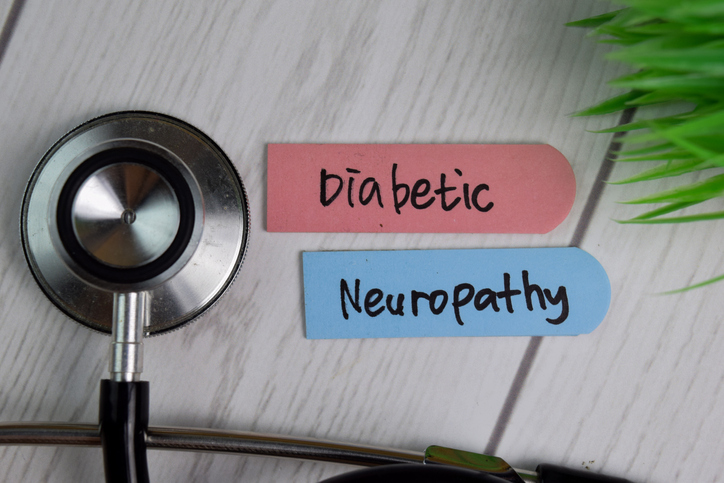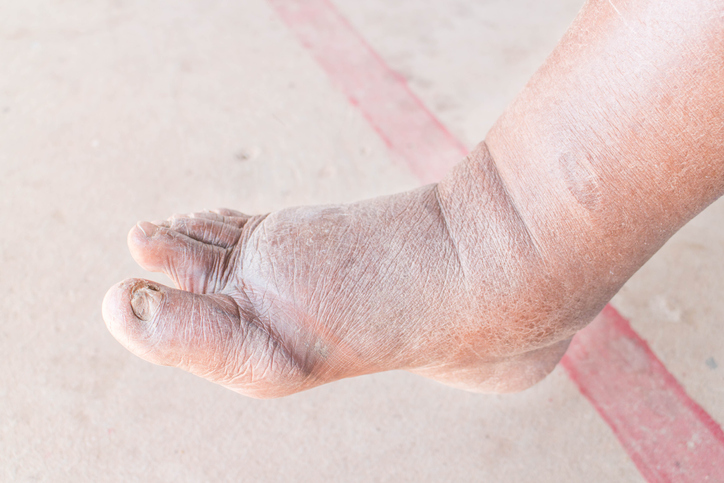Pain
Types of Diabetic Neuropathy

Diabetic neuropathy is categorized into four main types: peripheral, autonomic, proximal and focal. An individual with diabetes may have one or multiple types of diabetic neuropathy. Symptoms of the condition depend on the type of neuropathy and which nerves are affected.
Peripheral neuropathy
Peripheral neuropathy, also known as distal symmetric peripheral neuropathy, is the most common type of diabetic neuropathy. It typically affects the legs and feet first and may eventually affect the arms and hands. In rare cases, the abdomen and back are affected. Symptoms range from mild to severe and often worsen during the night. Symptoms of peripheral neuropathy include the following:
- Tingling or burning sensations
- Numbness or reduced sensitivity to temperature changes or pain
- Sharp pains or muscle cramps
- Increased sensitivity to touch
- Muscle weakness
- Balance and coordination issues
- Serious foot issues, including ulcers, infections, or bone and joint pain
Managing blood sugar levels can ease early symptoms of peripheral neuropathy. Medications may help reduce pain levels. Managing peripheral neuropathy includes checking for sores on the feet and legs daily, applying lotion on the feet, taking care of toenails, consulting a podiatrist if needed, and wearing comfortable shoes. Shoes should always be worn to avoid injury to the feet.
Autonomic neuropathy
Autonomic neuropathy is the second most common type of diabetic neuropathy. It occurs when diabetes damages the autonomic nervous system, which is the nervous system that controls the involuntary functions of organs and muscles. Autonomic neuropathy can affect the heart, bladder, intestines, eyes, stomach, or sex organs. Symptoms include the following:
- Inability to sense low blood sugar (hypoglycemia)
- Bladder or bowel issues
- Gastroparesis (slow stomach emptying), which can cause nausea, vomiting, and loss of appetite
- Changes in how the eyes adjust from light to dark and vice versa
- Decreased sexual response
Symptoms of autonomic neuropathy differ depending on the affected area:
Digestive system
- Bloating
- Diarrhea or constipation
- Heartburn
- Nausea or vomiting
- Trouble swallowing
- Feeling full after small meals
Cardiovascular system
- Fainting or lightheadedness upon standing
- Fast or abnormal heartbeat
- Dizziness
- Low blood pressure
- Nausea or vomiting
- Feeling full sooner than usual
Sex organs
- Inability to have or keep an erection (men)
- Dry or reduced ejaculation (men)
- Reduced vaginal lubrication (women)
- Reduced or no orgasms (women)
Urinary system
- Trouble emptying the bladder
- Bloating
- Leaking urine (incontinence)
- Increased urination at night
Proximal neuropathy
Proximal neuropathy, or diabetic amyotrophy, is rare and most commonly affects nerves in the legs, thighs, buttocks or hips. The chest area or abdomen can also be affected. Proximal neuropathy most commonly affects adults 50 years of age or older with fairly well-controlled type 2 diabetes. Men are affected more than women. Symptoms typically affect only one side of the body but can spread to the opposite side. Symptoms of proximal neuropathy include the following:
- Pain in a hip, thigh or buttock that may be sudden and severe
- Weakness of the thigh muscles
- Difficulty rising from a seated position
- Severe stomach pain
Focal neuropathy
Focal neuropathy, also known as mononeuropathy, consists of two types: cranial and peripheral. Focal neuropathy involves damage to a specific nerve or group of nerves, most often in the head, torso or leg. It is usually very painful and occurs suddenly. Carpal tunnel syndrome is a type of focal neuropathy that affects approximately 25% of people with diabetes. Symptoms include the following:
- Difficulty focusing
- Double vision
- Aching behind one or both eyes
- Paralysis on one side of the face (Bell's palsy)
- Numbness, pain or tingling in the hand or fingers, with the exception of the pinky
- Weakness in the hand or big toe
- Severe pain in a specific area such as the lower back, pelvic region, front of the thigh, outside the calf, or inside the foot
- Chest or abdomen pain that may be mistaken for a heart attack or appendicitis


















